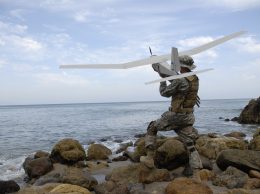Vasquez: Navy’s pivot to Pacific benefits Ventura County
An additional 700 military personnel will come to Naval Base Ventura County to operate a unit of the Navy’s first large drone system, the base commander told a gathering of business leaders in Thousand Oaks on Thursday.
Capt. Lawrence Vasquez talked about the economic impact of the naval base at a Corporate Leaders Breakfast at California Lutheran University. He said the base, the largest employer in Ventura County, has 19,000 employees, 66 percent of them civilians, and the average annual pay is $67,000. The base generates $79.5 million in state and local tax revenues annually and has a $1.9 billion economic impact on the county, he said.
Vasquez said the national defense strategy is pivoting toward the Pacific, and Naval Base Ventura County is positioned to benefit from that. He cited some new systems that the Navy is developing, some of which will be based or maintained in Ventura County.
The Navy’s new MQ-4 Triton drone is designed for maritime surveillance over a range of 2,000 nautical miles. Vasquez said that when Navy representatives first talked about basing West Coast Tritons in Ventura County, they were envisioning about 90 sailors to be stationed here. As they looked at the facilities at Point Mugu Naval Air Station, they liked what they saw and the number went up to 700, he said. Counting family members, about 2,000 people will be added to the local economy, starting with a handful this year and fully ramping up by 2015, he said.
The Fire Scout drone, an unmanned helicopter which can take off from destroyers, will also be based in Ventura County, arriving in the summer, Vasquez said. The naval base will be the West Coast maintenance hub for those drones.
Another new activity at the base involves the Navy’s newest seagoing vessel, the Littoral Combat Ship, or LTV. It is basically a hull that can accept 12 or 13 different mission modules, such as mine warfare or humanitarian aid. The boxy modules can be swapped out rapidly to give the ship great versatility at a lower cost than building destroyers. Vasquez said the Navy has four LTVs, and all the modules for the West Coast will be maintained at Port Hueneme.
Capt. Vasquez gave examples of contracts awarded in fiscal year 2012 by some of the 80 commands on the naval base as evidence of its economic impact. The Naval Facilities Engineering Expeditionary Warfare Center issued contracts worth $677 million, and the Naval Surface Warfare Center at Port Hueneme awarded $302 million, he reported.
The drones supported at the Ventura County base are expected to attract more local investment in unmanned aerial vehicles. Vasquez alluded to a recent study that put drone investment in California at $2 billion in the first three years, growing to $14 billion by 2025.
The commander talked about the effects of the budget sequester that has limited federal spending authority. So far, it has affected relatively little things that could turn into big things, he said. For example, he can’t afford to get the grass cut on the base. Until recently, he was unable to repair power boxes in the hangars that house E-2 aircraft, so maintenance had to be performed outside on the tarmac, even on hot days. Over time, personnel will question whether they joined a world class organization and whether they should re-enlist, he said.
On a larger scale, the Navy has been forced to send sailors on eight-month deployments instead of six months, with only a five-month break at home, he said, as a result of pressing mission demands.
Vasquez said the Navy traditionally had 60 percent of its assets based on the Atlantic Coast and 40 percent in the Pacific, but that has changed to 50-50 and is moving toward 60 percent based in the Pacific. He said Naval Base Ventura County is well positioned to take advantage of the shift, with its deepwater port at Port Hueneme, the Point Mugu Naval Air Station that houses four E-2 Hawkeye squadrons and a 36,000-square-mile-nautical test range.
He said Ventura County’s skilled work force is an advantage, with 30 percent of residents having earned bachelor’s degrees.
Vasquez cited a number of focus areas for the base and the Navy as a whole: conservation of energy and developing biofuels for military use; dialogue with local communities to ward off encroachment of airspace, and outreach to schools. He described a recent demonstration exercise off Hawaii where Navy destroyers and aircraft used biofuels during operations.












